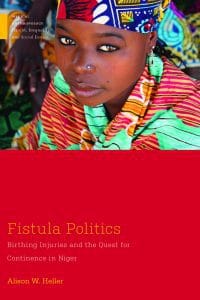How Health Systems Hurt Women. Review of Fistula Politics by Alison Heller, Rutgers University Press (2018).
Medica l anthropology has come a long way from its initial focus on the interpretive dimensions of health and sickness. The Medical Anthropology series from Rutgers University Press provides a showcase for contemporary explorations of lives lived through the intersection of everyday practices, transnational health systems and global inequalities.
l anthropology has come a long way from its initial focus on the interpretive dimensions of health and sickness. The Medical Anthropology series from Rutgers University Press provides a showcase for contemporary explorations of lives lived through the intersection of everyday practices, transnational health systems and global inequalities.
Fistula Politics. Birthing Injuries and the Quest for Continence in Niger by Alison Heller is an ethnographic account of the experiences of women left incontinent by injuries they sustained through giving birth in the West African country of Niger, and of the clinics and humanitarian organizations which make claims to save them. The book, based on extended fieldwork and life history interviews, strives to show how ordinary women’s lives are changed by obstetric fistula while confronting the stereotypes of abject social exclusion commonly circulated in the emotive marketing of Western development agencies.
The book’s main strength is showing how different women are affected by the injuries they sustain through prolonged labor which often results in the death of the child. Its most revealing insight, essential for those seeking to improve maternal health in low income settings, is the contribution of role strong local support networks in determining how far the effects of injuries acquired during delivery lead to social withdrawal and marginalization. Heller’s detailed ethnography explores how pre-existing vulnerabilities, of which the most significant was the loss of a woman’s own mother, predispose some unfortunate women to extreme social isolation. Whether they had previously borne surviving children, or were first or second wives, were also likely to affect women’s abilities to sustain their social selves as they strive to manage their incontinence.
Shame, seclusion and reduced social interactions did, however, characterize the lives of most women affected by obstetric fistula, provoking an ongoing, frequently unsuccessful, quest for treatment. Occasional fistula repair clinics, the majority supported by foreign, mainly US funded, humanitarian organizations, operate within an inadequate and overstretched health system slanted towards the priorities of better off urban residents. Niger’s health system cannot meet the needs of women living in remote rural locations whose birthing injuries are caused, in large part, by delays in the referral hierarchy. Rural women’s first point of contact with maternity services are understaffed health centers far from the sites of obstetric capability where complex births could be more safely managed.
Selection for fistula repair surgery is a lottery based on the likelihood that intervention will be successful and the availability of skilled medical personnel whose flying visits are financed through international philanthropy. Those not selected wait, sometimes for years at a time, in the hope that they can access future treatment. Because the system favors those whose fistulas appear amenable to simple surgical procedures, women requiring more extensive operations are either left untreated or receive ineffective treatment. Many such women, desperate to regain continence, subject themselves to repeat, often unsuccessful, operations.
This sensitive and compassionate book shows how the prevalence of fistula in low income countries in Sub Saharan Africa today cannot be understood as an unfortunate consequence of female reproductive processes. The high incidence of fistula in Niger is socially and politically produced through ineffective maternity services and the transnational philanthropic initiatives which prioritize surgical repair for a small number of women over the repair of the fractured health system.
Fifty years of neo-liberal polices and a thoughtful reflection on the persistent colonial rationalities which inform the representation of the problem and its technical surgical fixes promoted through philanthro-capitalist humanitarianism are invoked explain the current state of the health system in Niger and the orientation of interventions directed at helping women with fistula across sub Saharan Africa. These points are important. But these institutional factors are accentuated by, and co-produce, a culture of acceptance of poor reproductive care, high incidence of still birth and staggering rates of maternal mortality which is enacted through the health seeking behavior of mothers and the practices of clinic staff. The book’s concluding chapter rightly argues that changing these expectations and the politics which creates them must be the starting point for more effective health interventions.
Why women’s reproductive health is so little valued within a socio-political milieu where reproduction is paramount is left largely unexplored in a book which is at pains to distance itself from the explanatory tropes of cultural practice and failures of local knowledge conventionally invoked by Western aid agencies. Nevertheless, the reference point of Western humanitarianism and its strategies of representation provides an entry point for wider debates about humanitarian philanthropy, health systems and human rights. A recommended read for scholars and practitioners in global public health, international development and medical anthropology.
Maia Green works on the anthropology of international development and issues of social transformation in East Africa. She has written on diverse topics ranging from anti-witchcraft practices to the proliferation of NGOs. Maia Green teaches at the University of Manchester.